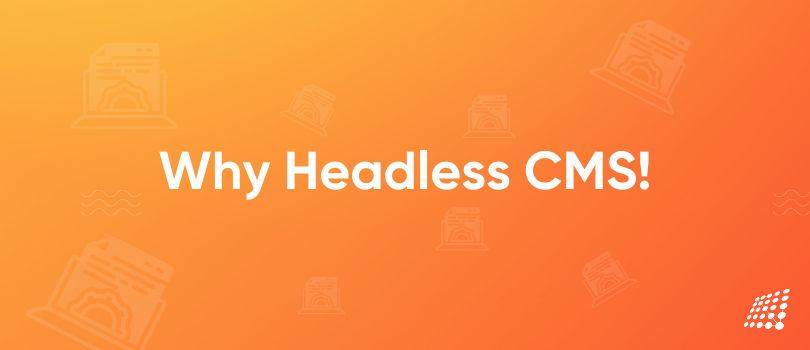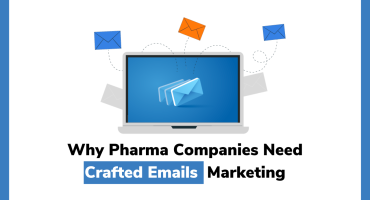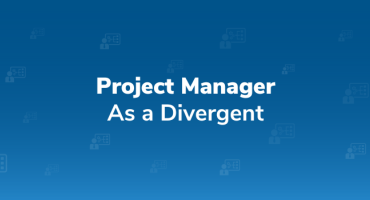Here’s Why Headless CMS is the Way Forward!

Whether you like it or not, omnichannel marketing and Content Management Systems for websites is crucial in today’s competitive environment. Why? Well, with an omnichannel marketing strategy, teams can meet their consumers where they are and cleverly send the right message across. A headless Content Management System CMS can make it seamless for companies and enterprises to deliver personalized content across multiple channels.
Also, given how the existence of IoT (Internet of Things) or connected devices is ever-expanding, one thing is established — Headless CMS is the way forward and it is definitely here to stay! And why not? After all, the platform provides a one-stop solution for developers to create and publish one-of-a-kind and dynamic content no matter what the type of platform.
While traditional CMS solutions obstruct the scope of functioning with improved content opportunities and fast, the CMS Headless helps users manage, create, and modify content on a website without requiring specialized technical expertise.
But, what exactly is CMS (Content Management System)? What does Headless CMS mean, what are the benefits of Content Management System, and why is it so relevant in today’s times? To know all of this and more, read on to know everything you need to know about CMS Headless and why it is the way forward.
What is CMS?
Before moving forward to headless, let’s have an overview of what is Content Management System CMS and its surroundings.
A Content Management System often abbreviated as CMS is a tool that helps build a website without needing to write all the code from scratch (you don’t even need to know how to code at all). It is software that helps users create, manage, and modify content on a website without requiring specialized technical knowledge. Technically speaking, content management systems for websites are made up of two core parts.
CDA: CDA (Content Delivery API) is the backend behind the scenes that take the content that we input in CMA, stores it properly, and makes it visible to visitors.
CMA: (Content Management Application) is the part that allows us to add and manage content on our site.
In recent years the e-commerce industry has undergone lots of changes. Those tremendous changes require future-ready stack architecture. Previously, when monolithic architecture was used, it was very restricted.
That architecture used to provide everything in one place and due to this the front-end and back-end were tightly coupled and it used to increase the dependency level.
For that reason, any single or small change required more time, cross-team coordination, and multiple failure opportunities. Sometimes, it included responsiveness and slowdown issues as well.
While the traditional CMS is an example of monolithic architecture, the Headless CMS increases lots of unnecessary complexity and offers you the benefits of Content Management System cleverly.
There are three types of CMS:
- Traditional CMS
- Decoupled CMS
- Headless CMS
From these three content management systems, the most popular one that we will describe is the Headless CMS.
What is a Headless CMS?
In these several years, headless has become a buzzword and gained a huge amount of popularity due to the architecture it follows. This architecture separates the front-end and back-end layers and creates a bridge between them via API.
The front-end calls the API to get the data from the back-end and displays it. The most amazing part here is that it allows us to deploy content across any front-end layer. This is key to omnichannel strategies because it lets you integrate content into any system, software, or website just by calling the APIs the Headless CMS exposes.
All in all, a CMS Headless is a Content Management System CMS that provides backend-only functionalities, making content accessible through a GraphQL or REST API and displayable on any device possible. All in all, it’s safe to presume that the headless CMS is the best CMS content management system for your web experiences.
When Should You Choose Headless?
Headless Content Management Systems for websites are changing the way content and development teams work and collaborate. It's a disruptive technology that's gaining traction among major brands.
Though Headless CMS is ruling the roost for some time now, before jumping into this CMS or shifting to it, we need to know in which scenarios Headless CMS can prove to be an advantage for us.
Some specific criteria include the following:
If we are building an e-commerce website that contains large amounts of content and we need to update that content frequently, the features of a Content Management System, that is, Headless CMS is the solution. It helps us create, update and manage the content easily and quickly without affecting the front layer.
If the target is not only for the web and we need to reach people in depth, the Headless CMS works wonders. For instance, if we want to be able to achieve omnichannel support and scale our content to multiple digital channels to deliver tailored customer experiences, Headless is the solution we must pick as the old CMSs are not going to serve this purpose.
If the priority is publishing the content with high speed, thanks to content delivery networks (CDNs), many headless CMS providers enable delivering content to any corner of the world in a fraction of a second. This isn’t possible with legacy content management systems that don’t expose their APIs. As a result, headless CMS is the best CMS content management system, suited for businesses that rely on high-speed content delivery.
Why should you move to Headless?
While the benefits of headless CMS are numerous, below are some of the major reasons.
A headless Content Management System CMS has many perks, including agility and flexibility, speed, more effortless scalability, high availability, increased security, a multichannel approach, ease of use, and a smooth learning curve.
Headless enables us to move faster
As the frontend and backend are not coupled with each other and we really need not worry about the backend while updating the front-end, it enables us to update contents without having any trouble. This means as soon as any changes are required, we can keep up with those requirements with in no time.
An increased speed
A headless Content Management System CMS lets you add new content without waiting for it to be published on your site. That means faster turnaround times for your writers and less time wasted waiting for pages to refresh. Since everything happens in a single request, fewer network overhead and connections are being made. Fewer requests mean that you'll get pages to your users faster.
Optimization becomes easier
Previously, with a monolithic architecture, it often took more than a week to update any changes as they needed to follow some bunch of levels. With a Headless Content Management System CMS, we can now easily skip all those steps as the content managers don't need to wait for the developer’s help to update any content. The content managers can update, create and modify the content by themselves.
Developers Satisfaction
With Headless, Content Management Systems for websites have become more flexible as developers can choose any programming language to build the front end. Developers have the freedom to choose a language of their own choice. They don’t need to take the headache of updating new content, rather they can spend time working on the developing part.
More effortless scalability and high availability
Scalability is important when choosing the right Content Management System CMS. Headless CMS empowers developers to build highly scalable architecture with higher availability than traditional CMS solutions. The front and back end separation ensures everything runs smoothly and at scale. Thanks to scalability, it's easy to optimize your website seamlessly.
Increased security
With a Headless Content Management System CMS, the content is more secure than before. Often the API used to provide content via headless CMS is read-only. This provides a level of security that might be unavailable with a conventional CMS. Thus, a headless CMS is relatively more secure than a typical conventional CMS. With no portal, visitors can enter data, and your site is more secure against hackers and other threats. The separation of the front-end and back-end is a great advantage. The back-end contains all the content, but it is not accessible to the front end. The system is set up so that if there is a breach in one section, like a page on the website, it will not affect the other pages and functions of the site.
Agility and flexibility
Another one of the important features of a Content Management System (Headless) is agility and adaptiveness. Adapting to the new digital transformation requires a high level of agility and flexibility that will help you speed the process, ensuring your project is up and running. The headless architecture lets you start working on your project and deploy your applications immediately. Because the front and back end are decoupled by default, you have complete freedom to choose how you want to build your application, and this dramatically reduces your development time and the cost of creating new features for your website.
Easy to learn and use
With a Headless Content Management System CMS, you can manage your digital content and digital assets quickly and on the fly. Unifying content in centralized content hubs allows teams to manage their assets and copy in one place, supporting multiple websites, apps, and other channels. Users can see only the relevant fields when using the platform to create content or landing pages. Meanwhile, developers can efficiently work on your content infrastructure and interface.
A multichannel approach:
The Headless CMS is also the best CMS content management system owing to its multichannel approach. The main benefit of a Headless CMS is that your website becomes fully functional through any channel or device - mobile apps, IoT devices, smartwatches, or single-page applications, to name a few. This way, your users have access to the same content regardless of their device. With content as a Service (CaaS), you don't have to worry about the back-end; focus on building great content for your users.
What do organizations need today?
Few businesses worry about how a Headless Content Management System CMS grows and changes, but all companies care about the many platform choices available to their customers. A great example is that of e-commerce. Each day (or so it seems) brings a new interface and new ways to attract customers. Your company won't want to wait to recode or buy an expensive, limited plug-in when, with the Headless option, you can take advantage of microservices immediately.
Headless CMS performance will progress over time, and once you've put yours in place, you can take advantage of performance optimization across the board. As a result, you can focus on content creation and display instead of content management.
Headless CMS opens new frontiers for content
Headless CMS represents an inflection point for the industry. It's API-first, cloud-first, and content-first. It removes many limitations of traditional CMSes and comes with new challenges. Unlike the conventional Content Management System CMS, the Headless CMS focuses only on content creation and its delivery via API. It doesn't come with any "head" - there's no templating engine that would say how the content is displayed. It means the Headless CMS strictly separates content and its presentation. Once the content is created, it can be displayed on any device using any technology. This separation of concerns makes Headless CMS a perfect fit for building modern digital products using a microservices architecture.
Core advantages for marketers
Marketers can create content just once without worrying about different channels, administration issues, or technical aspects. Usually, with the Headless CMS, a handy text editor is available, allowing you to format the text correctly and focus on the user experience.
Core advantages for developers
Besides marketers, Content Management Systems for websites help developers in a huge way too. No more back-end restrictions or obstacles caused by the lack of expertise in a given programming language. Developers can use the tools they love and focus on building beautiful interfaces without worrying about performance issues. Creating different content delivery channels has never been so easy.
Core advantages for users
Users experience faster and more responsive applications. They don't have to worry that they will miss some information when using different channels for the same application.
Drawbacks of using Headless CMS
Despite the apparent advantages of a Headless CMS, some drawbacks are worth mentioning.
First, building initial infrastructure can take time, planning, and financial resources. Developers should work simultaneously with different codebases for every single front-end framework. Since your teams will be working with APIs and various disparate channels, this essentially means adding another piece of the puzzle to the pre-existing complexity. Complexity often brings additional costs, so a Headless CMS will be more expensive to implement and manage.
Onboarding is needed for teams to adjust to the lack of a presentation layer, or teams may build presentation layers using integrations. So a Headless CMS comes with a more profound learning curve. The advantages and disadvantages of content management system xist, it’s how you manage and rise above the challenge that also makes this CMS worth it.
Conclusion: The Headless CMS is the future of content
These days we want to consume high-quality content everywhere and as soon as possible. That's why providing the best tools for both content and software creators is essential. In a modern world, every product owner must be proactive and use every opportunity to serve content on a new device as soon as it is available for a larger audience.
For the first time, content quality is as important as its availability. It's good to have experts who will take care of the business logic for your application, but it's better to have them and pay less. Outsourcing is the key to outstanding performance and lower costs, and the Headless Content Management System CMS is the best solution. Having a well-maintained back-end for an application is not that expensive if you decide to use the Headless CMS instead of doing everything on your own, and the peace of mind you'll get from it will be priceless!
Hopefully, the above information will help you to decide why Headless should be the first choice to take your business to the next level. In one words, to cope up with the future of business, we must go Headless!
Revamp your website's content management system with SJ Innovation's Headless CMS services. We show you the different types of content management systems and how they can benefit your website in the best way.

Why Pharma Companies Need Crafted Emails Marketing

SJ Innovation Appreciates Our Happy Clients


